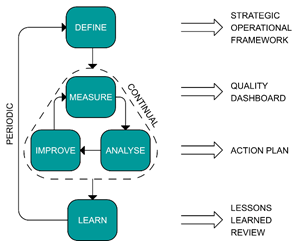| Expand | ||
|---|---|---|
|
...
|
| Expand | ||
|---|---|---|
|
...
...
an accountability and quality assurance system for the response
Know the AAP and GWC accountability framework and train partners on it
There is a common agreement among actors that the highest possible quality of response should be achieved. There is however no consensus on what exactly quality means in the field, at which phase of the response are we expected to reach peak quality, and who is accountable for ensuring it. For many contextual reasons (lack of competent staff, security and access issues, lack of materials locally available etc) it can be challenging for aid organizations to reach high quality standards. It is therefore important for the WASH sector to agree on clear achievable quality targets to be respected by all partners, thus making quality monitoring possible.
Ensuring that the WASH partners can provide to the affected populations a humanitarian response complying with minimum standards of quality has become a priority for the humanitarian WASH community. WASH Coordination platforms therefore should as much as possible ensure that the enabling environment is conducive for partners to monitor the quality of the WASH response (as a sector) in countries.
Partners implementing the WASH response must ensure that it:
- Is appropriate and relevant - communities and people affected by the crisis should have access to water and sanitation infrastructure and services, as well as receive key hygiene messages and items that meet their needs and be culturally appropriate;
- Is impartial - the targeted communities of WASH programmes should be based on a sound vulnerability criteria ;
- Is as participatory as possible - communities and people affected by crisis should know their rights and entitlements, have access to information, participate in decisions that affect them, and have the possibility to provide feedback to WASH partners;
- Is effective and timely - the WASH response should be realistically designed, sized and phased so that it is delivered in a timely manner, in line with the capacity of the sector;
- Strengthens local capacities and avoids negative effects - WASH partners, should to the maximum extent possible, build their response on local capacities and work towards improving the resilience of communities and people affected by crisis.
A humanitarian WASH response accountability and quality assurance system consist in the set up of mechanisms to guaranty a certain level of quality in the response, the monitoring of these mechanism and ensure issues are addressed when necessary. Response quality is defined by the GWC as the results of 5 elements, as per the below diagram:
...
The WASH response must be coordinated not only to maximise outputs and number of beneficiaries reached, but also to make real progress towards response general objectives and ensure it is safe, inclusive, participatory and effective. Coordination platform can address this by setting and following up the implementation of a Accountability and Quality Assurance Systems (AQAS). AQAS is a process implemented at national level that aims at ensuring standards for quality and accountability in humanitarian WASH responses are agreed, met and maintained, with continuous improvement. It provides a way to monitor the WASH response against a jointly agreed, contextually relevant quality and accountability framework. An effective AQAS is the joint responsibility of the Cluster Lead Agency, the Cluster Coordinator, Cluster partners at national and subnational level and donors. As humanitarian response will always face external constraints, the aim of AQAS should be to provide the highest quality possible in the context by making improvements over time, rather than reaching an absolute level of quality. The AQAS comprises:
- A Guidance Note describing the steps required for National WASH Clusters to set up routine systems for an accountability and quality assurance and within the humanitarian programme cycle. This involves a systematic and collective process of setting up quality benchmarks, quality monitoring, taking action to address issues and learning for continuous improvement. This process is summarised in the diagram on the right and in the below table.
- The accompanying modular analytical framework provides guidance on monitoring approaches, standards and indicators for quality monitoring in key WASH areas. The framework has been designed as a flexible tool so that National Humanitarian WASH Coordination Platforms may focus on the areas where WASH partners want to monitor quality in priority. So far, three Modules on Public Health Risks, WASH Service Provision and People-Centred Programming have been developed;
Figure 1: The AQAS process and Key Outputs
| STEP | DESCRIPTION | OUTPUT | TIMING |
|---|---|---|---|
1. DEFINE | The WCC convenes a TWiG. The TWiG choses the most appropriate modules of the modular analytical framework, set Key Quality Indicators (KQI) benchmark, agree on timing, approach and roles for data collection, reporting and analysis. | AQAS definition within the Strategic Operational Framework (SOF) validated by the SAG |
|
2.MEASURE | KQIs are continuously monitored by cluster partners and Third Party Monitors. Data is reported to the cluster IMO who produces Quality snapshots. | Continuous measurement, analysis and improvement through regular coordination meetings; ad-hoc alerting of priority gaps. | |
3.ANALYSE | Quality Snapshot shared by IMO with cluster partners; quality gaps are prioritised; Action plans for addressing gaps are developed by the . | Action plan | |
4.IMPROVE | Action plans are implemented by partners and monitored by the TWiG; Information about issues identified and action plans is fed back to the affected population | Corrective actions Feedback to the affected population | |
| 5.LEARN | Trends, monitoring data and action plans are periodically reviewed by the TWiG; lessons learned are produced by partners including the CLA; SOF is revised accordingly by the SAG | Updated AQAS / SOF Lessons learned disseminated to GWC partners, decision makers and donors | Periodically
|
Table 1: The AQAS process and Key Outputs

